The AMD Radeon R9 290X Review
by Ryan Smith on October 24, 2013 12:01 AM EST- Posted in
- GPUs
- AMD
- Radeon
- Hawaii
- Radeon 200
XDMA: Improving Crossfire
Over the past year or so a lot of noise has been made over AMD’s Crossfire scaling capabilities, and for good reason. With the evolution of frame capture tools such as FCAT it finally became possible to easily and objectively measure frame delivery patterns. The results of course weren’t pretty for AMD, showcasing that Crossfire may have been generating plenty of frames, but in most cases it was doing a very poor job of delivering them.
AMD for their part doubled down on the situation and began rolling out improvements in a plan that would see Crossfire improved in multiple phases. Phase 1, deployed in August, saw a revised Crossfire frame pacing scheme implemented for single monitor resolutions (2560x1600 and below) which generally resolved AMD’s frame pacing in those scenarios. Phase 2, which is scheduled for next month, will address multi-monitor and high resolution scaling, which faces a different set of problems and requires a different set of fixes than what went into phase 1.
The fact that there’s even a phase 2 brings us to our next topic of discussion, which is a new hardware DMA engine in GCN 1.1 parts called XDMA. Being first utilized on Hawaii, XDMA is the final solution to AMD’s frame pacing woes, and in doing so it is redefining how Crossfire is implemented on 290X and future cards. Specifically, AMD is forgoing the Crossfire Bridge Interconnect (CFBI) entirely and moving all inter-GPU communication over the PCIe bus, with XDMA being the hardware engine that makes this both practical and efficient.
But before we get too far ahead of ourselves, it would be best to put the current Crossfire situation in context before discussing how XDMA deviates from it.

In AMD’s current CFBI implementation, which itself dates back to the X1900 generation, a CFBI link directly connects two GPUs and has 900MB/sec of bandwidth. In this setup the purpose of the CFBI link is to transfer completed frames to the master GPU for display purposes, and to so in a direct GPU-to-GPU manner to complete the job as quickly and efficiently as possible.
For single monitor configurations and today’s common resolutions the CFBI excels at its task. AMD’s software frame pacing algorithms aside, the CFBI has enough bandwidth to pass around complete 2560x1600 frames at over 60Hz, allowing the CFBI to handle the scenarios laid out in AMD’s phase 1 frame pacing fix.
The issue with the CFBI is that while it’s an efficient GPU-to-GPU link, it hasn’t been updated to keep up with the greater bandwidth demands generated by Eyefinity, and more recently 4K monitors. For a 3x1080p setup frames are now just shy of 20MB/each, and for a 4K setup frames are larger still at almost 24MB/each. With frames this large CFBI doesn’t have enough bandwidth to transfer them at high framerates – realistically you’d top out at 30Hz or so for 4K – requiring that AMD go over the PCIe bus for their existing cards.
Going over the PCIe bus is not in and of itself inherently a problem, but pre-GCN 1.1 hardware lacks any specialized hardware to help with the task. Without an efficient way to move frames, and specifically a way to DMA transfer frames directly between the cards without involving CPU time, AMD has to resort to much uglier methods of moving frames between the cards, which are in part responsible for the poor frame pacing we see today on Eyefinity/4K setups.
CFBI Crossfire At 4K: Still Dropping Frames
For GCN 1.1 and Hawaii in particular, AMD has chosen to solve this problem by continuing to use the PCIe bus, but by doing so with hardware dedicated to the task. Dubbed the XDMA engine, the purpose of this hardware is to allow CPU-free DMA based frame transfers between the GPUs, thereby allowing AMD to transfer frames over the PCIe bus without the ugliness and performance costs of doing so on pre-GCN 1.1 cards.
With that in mind, the specific role of the XDMA engine is relatively simple. Located within the display controller block (the final destination for all completed frames) the XDMA engine allows the display controllers within each Hawaii GPU to directly talk to each other and their associated memory ranges, bypassing the CPU and large chunks of the GPU entirely. Within that context the purpose of the XDMA engine is to be a dedicated DMA engine for the display controllers and nothing more. Frame transfers and frame presentations are still directed by the display controllers as before – which in turn are directed by the algorithms loaded up by AMD’s drivers – so the XDMA engine is not strictly speaking a standalone device, nor is it a hardware frame pacing device (which is something of a misnomer anyhow). Meanwhile this setup also allows AMD to implement their existing Crossfire frame pacing algorithms on the new hardware rather than starting from scratch, and of course to continue iterating on those algorithms as time goes on.
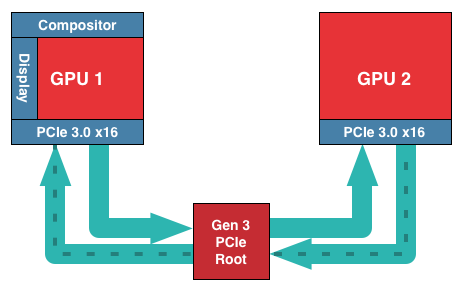
Of course by relying solely on the PCIe bus to transfer frames there are tradeoffs to be made, both for the better and for the worse. The benefits are of course the vast increase in memory bandwidth (PCIe 3.0 x16 has 16GB/sec available versus .9GB/sec for CFBI) not to mention allowing Crossfire to be implemented without those pesky Crossfire bridges. The downside to relying on the PCIe bus is that it’s not a dedicated, point-to-point connection between GPUs, and for that reason there will bandwidth contention, and the latency for using the PCIe bus will be higher than the CFBI. How much worse depends on the configuration; PCIe bridge chips for example can both improve and worsen latency depending on where in the chain the bridges and the GPUs are located, not to mention the generation and width of the PCIe link. But, as AMD tells us, any latency can be overcome by measuring it and thereby planning frame transfers around it to take the impact of latency into account.
Ultimately AMD’s goal with the XDMA engine is to make PCIe based Crossfire just as efficient, performant, and compatible as CFBI based Crossfire, and despite the initial concerns we had over the use of the PCIe bus, based on our test results AMD appears to have delivered on their promises.
The XDMA engine alone can’t eliminate the variation in frame times, but in its first implementation it’s already as good as CFBI in single monitor setups, and being free of the Eyefinity/4K frame pacing issues that still plague CFBI, is nothing short of a massive improvement over CFBI in those scenarios. True to their promises, AMD has delivered a PCie based Crossfire implementation that incurs no performance penalty versus CFBI, and on the whole fully and sufficiently resolves AMD’s outstanding frame pacing issues. The downside of course is that XDMA won’t help the 280X or other pre-GCN 1.1 cards, but at the very least going forward AMD finally has demonstrated that they have frame pacing fully under control.
On a side note, looking at our results it’s interesting to see that despite the general reuse of frame pacing algorithms, the XDMA Crossfire implementation doesn’t exhibit any of the distinct frame time plateaus that the CFBI implementation does. The plateaus were more an interesting artifact than a problem, but it does mean that AMD’s XDMA Crossfire implementation is much more “organic” like NVIDIA’s, rather than strictly enforcing a minimum frame time as appeared to be the case with CFBI.


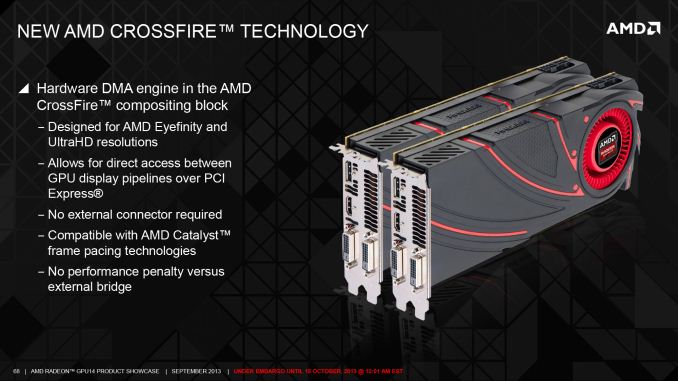
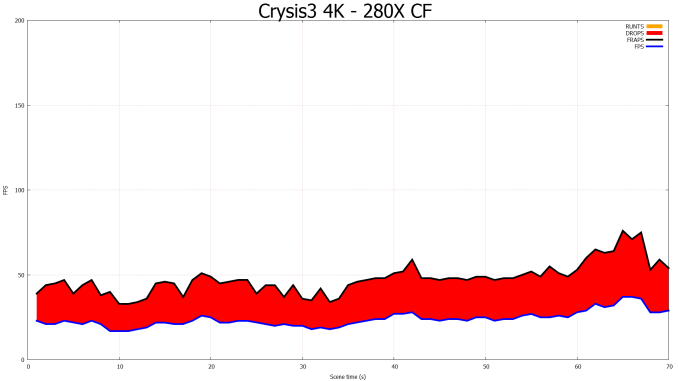
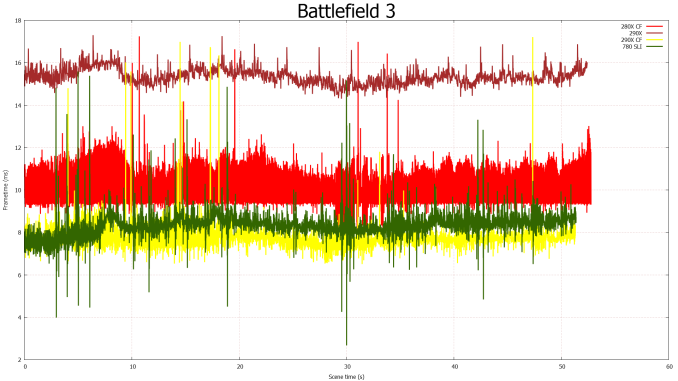
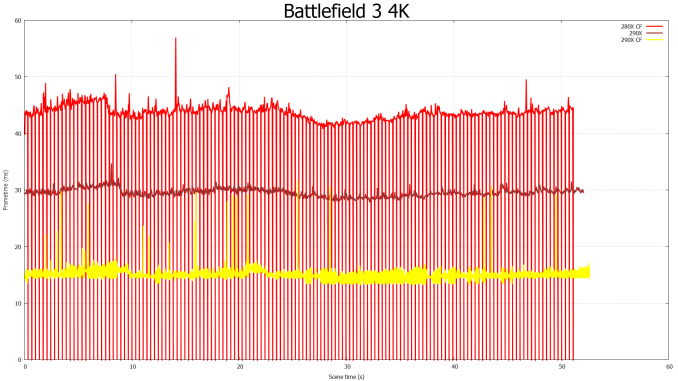








396 Comments
View All Comments
AtwaterFS - Thursday, October 24, 2013 - link
Nice, Nvidia has two choices, drop prices substantially, or drop trou.I certainly hope its the former, as I have no interest in seeing Jen-Hsun's pig in a blanket...
Wreckage - Thursday, October 24, 2013 - link
Not really the Titan slayer we were hoping for.After all this wait and hype it's not surpassing last years GK110. I guess we don't look for big gains in new chips anymore.
The Von Matrices - Thursday, October 24, 2013 - link
This is on the same process node as Titan. Big advances don't happen without process node shrinks, regardless of manufacturer.ninjaquick - Thursday, October 24, 2013 - link
A million times this... GCN is superior to Kepler, and probably Maxwell as well. It doesn't waste tons of die-space on large cache/special decoders/legacy bullshit. Game creators want massive arrays of simple math units that can voraciously crunch numbers, and that is what GCN delivers.EJS1980 - Thursday, October 24, 2013 - link
"GCN is superior to Kepler, and probably Maxwell as well"...HEHEH..... THIS IS PRETTY FUNNY, MAN......THANKS.....I NEEDED THAT! :PWill Robinson - Thursday, October 24, 2013 - link
Yeah right Wreckage...only slayed Titan by about $500 LOLIdiot.
chizow - Thursday, October 24, 2013 - link
Great price and performance from AMD without a doubt, it's not quite a clean sweep but it is certainly a convincing victory for R9 290X, especially at higher resolutions. 780Ti may come close or even exceed 290X, but the damage to Nvidia's product stack has been done.The symmetrical irony here is that this generation's price escalation that began at $550 with AMD's first 28nm part, Tahiti, has come full circle and brought back to balance with AMD's last 28nm part, Hawaii, again at that $550 price point.
I'm happy to see some balance back in the GPU market though, I stated this month's ago at 690 and Titan launch, that this $1K pricing model was an unsustainable business strategy for Nvidia. Now it's going to bite them squarely in the ass. They'll now reap what they sow and have to deal with the angst and anger from all of their most loyal fans who will undoubtedly feel as if they were cheated by the 690, Titan and even 780.
chizow - Thursday, October 24, 2013 - link
I guess it couldn't be all good news though, it looks like the leaked thermals, power consumption and acoustics weren't exaggerated. Definitely loud and hot, with high operating temps. I guess AMD really pushed the GPU to the max, I doubt there will be much more OC headroom, at least with the reference cooler.If Nvidia wasn't so greedy with 690/Titan/780 pricing 290X might've been the next Fermi with mixed reactions, but I'm sure the price and performance will overshadow heat/power concerns.
t41nt3d - Thursday, October 24, 2013 - link
NVIDIA won't be bitten in the ass at all due to the prices of the 690s and Titan. A god awful amount of people have paid $1000 (Including me) for one or more of these cards, and it's taken /8 Months/ for AMD to release a card that goes back and forth with the Titan - Doesn't outright beat it in some games, can go either way.NVIDIA have made a crapload of money from their two overpriced cards and have been reaping off this for a long time now, all they need to do is lower prices and no money lost. It's AMD who's been letting them get away with those prices for so long.
It seems a perfectly viable business strategy for them to have done what they've done and to be so successful at it.
chizow - Thursday, October 24, 2013 - link
I guess we will see, their job just got that much harder to try to sustain this $1000 pricing model now that a $550 card now matches and sometimes outperforms their $1000 card. What kind of performance do you think they're going to need next time to try and justify a $1000 pricetag?Again, Nvidia went down the path of an unsustainable business model predicated on the fact they would be an entire ASIC ahead of AMD. That lead was clearly short-lived due to Kepler's excellent overall performance, but Hawaii brought that dream back down to reality. Sure a bit late, but still in time to crash Nvidia's $1K parade.